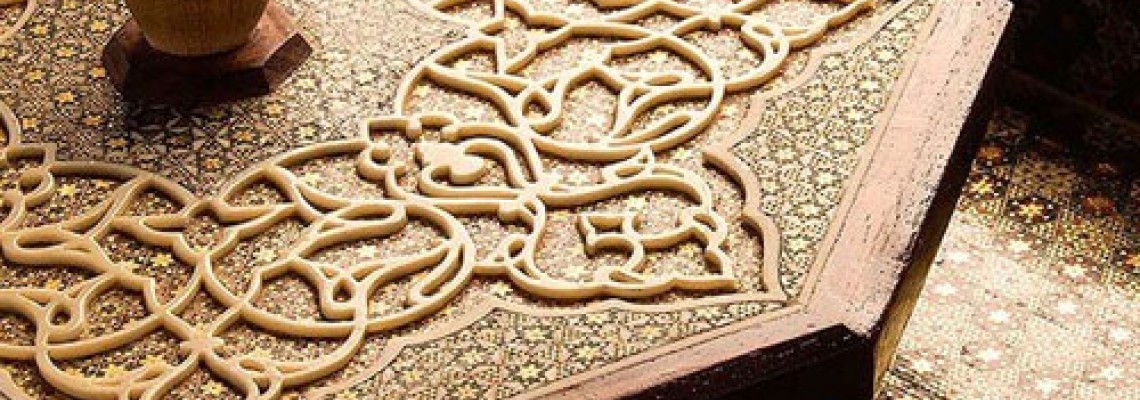
Khatamkari
Khatam is one of the memorable handicrafts of Isfahan which has a flourishing history. This artwork is known as a popular artwork because of the variety of products from which it is made. Isfahan intarsia is one of the famous Persian handicrafts. Their beautiful designs and colors attract the attention of every art lover because they are made of small triangles arranged side by side to form star-like shapes. This art was inherited from previous generations and should be passed on to the next generations.
Introduction to Khatam Kari Art
One of the traditional techniques is marquetry, which can be considered a kind of marquee. This art is very popular in different cities like Isfahan, Shiraz, and Tehran. There are many workshops where amateurs who want to learn this Iranian craft can participate in marquetry. Applying different stripes in a great geometric pattern can be the most important part of making this art because the master must pay special attention to the design and arrangement of colors and patterns.
Khatam Kari is one of the most famous arts in Iran, which has many followers at home and abroad. The surface of the wood is usually decorated with special materials such as wood, metal, and bone to create star-shaped forms. The smaller the shapes and patterns are, the higher the value of the masterpiece produced, as it requires a lot of concentration to match the colors and shapes.
Persian Khatam Kari
Persian Khatam Kari is known all over the world for its traditional design and elegance in making a product. Since its products are so diverse, everyone is interested in their practicality. Making inlays in Isfahan is one of the most complex tasks because it requires great care and attention. Various materials are needed to make the inlays. These include colored wood, ivory, bone, and a range of gold, silver, brass, and aluminum. Thin strips of colored material are glued together to create a triangular appearance. Large polygonal and rectangular shapes are then made.
The arts and crafts of Isfahan flourished in the Safavid period due to the presence of various masters and the kings' great attention to art and culture. The woods used at that time were mainly cypress, betel, pine, and walnut. Most of the inlay work included the production of mirror frames, windows, doors, pens, and boxes for various purposes, including the storage of the Koran or jewelry in various sizes.
Isfahan Khatam
The Isfahan Khatam is the most famous because the skilled Isfahani masters combine their love, talent, and creativity to produce the most beautiful handicrafts. Bazaar Mina is an online store for Iranian handicrafts and souvenirs. With the development of this inlay art in the Safavid era, most of the decorative parts of different places like Marble Palace and Saadabad Palace in Tehran were made with this art.
The doors of some holy religious shrines in Rey, Mashhad, Shiraz, and Qom are also decorated with the magnificent art of Isfahan inlay and attract the attention of every viewer. This magnificent masterpiece was not considered an important craft in the 18th and 19th centuries, but it became popular again during the reign of Shah Reza with the establishment of various art schools in the notorious cities of Iran.
Steps of making Khatam
The inlay is made in several steps of cutting very thin layers and gluing them to each other, which involves 400 steps from start to finish. The inlay is glued based on the plan, color, shape, dimensions, and location. They decorate the entire surface of the plan with boards prepared by repairs, making different plans and similar shapes or symmetrical shapes. Sanding, brushing, and undercutting, and finally sanding and smoothing the surface of the inlay and then lubricating and polishing with special materials such as sealants and polishers. The quality of the inlay depends on the good drawing and regularity of the card, all of which can be summarized in the skills of the craftsman.
Tips when buying a high-quality khatam
When buying one of the inlay products, make sure that the work surface is completely smooth and has no traces of primer. A high-quality inlay has symmetrical patterns and images, and its repeating images and patterns are the same size. The smaller the repeating images and patterns on the surface of the work, the higher the aesthetic value of the marquee. Shiraz is the cradle of Iranian marquetry art. However, you can also buy marquetry in other reputable and prestigious Persian handicraft stores throughout the country.

Leave a Comment